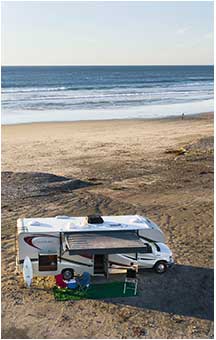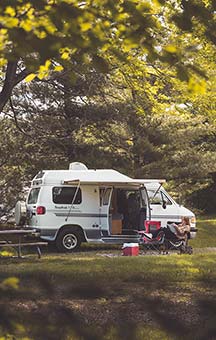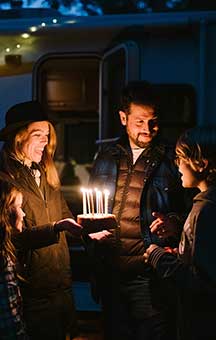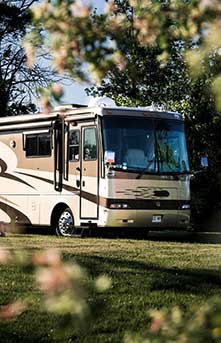You may not be able to control the weather when you’re out camping, but if you’re staying in an RV, you do have the power to control the temperature in your rig— with your RV thermostat, of course! Indeed, one of the biggest perks to RVing is being able to take the comforts of home, like heating and cooling, with you wherever you go.
Several components come together to give you this ability— namely your electric system, furnace, and air conditioner— but the thermostat is what gives you the real power. Without this nifty device, your HVAC system wouldn’t know what to do with itself!
We’ve compiled everything you need to know about RV thermostats into this handy guide. Read on to learn more about choosing, installing, using, troubleshooting your RV thermostat.
What does an RV thermostat do, exactly?
If you like to stay cool in the summer and toasty in the winter, you’ll want to be sure your RV is equipped with a thermostat!
A thermostat in your RV will be much like the ones that you find in your house. It serves as the controller for your RV air conditioner and heater. Without your thermostat, your A/C and heater will not receive the signals it needs to turn on and operate.
On a thermostat, you will usually find controls that allow you to:
- Turn the system off and on
- Select heating, cooling, or fan
- Adjust the RV temperature to your desire
- See what the current temperature in the RV is
But some types of thermostats do more than others. Here’s how they stack up against one another.
Types of RV thermostats
Though all thermostats do the same job, you’ll find several different types.
Analog RV thermostats
Analog thermostats are the ol’ tried and true. These are the most basic type of thermostats and rely on physics to operate. They are probably the most reliable of all thermostat models but aren’t as precise as digital options. To adjust the temperature, you simply move a slider instead of selecting an exact temperature.
Digital RV thermostats
Basic digital RV and travel trailer thermostats do the same thing as an analog thermostat but in a much more precise way. Instead of adjusting a slider and knowing the approximate temperature in the RV, you can get an exact readout. Using buttons, you can tell the thermostat exactly what temperature you want it to be. Nowadays, basic digital RV thermostats are just as affordable as the older style analog models.
RV Programmable thermostats
Programmable RV thermostats and smart thermostats are the newest kids on the block. Not only is the temperature readout and control digital, but you also get a whole host of other capabilities. This may include features like:
- Programmable temperature settings: Preset your RV temperature for different times of day. For example, if you like to snuggle under a pile of blankets in a cool room, you can set your thermostat so that your A/C starts cooling more around 9 pm.
- Wifi connectivity: Some modern smart thermostats even connect to wifi, giving you the ability to control it whether you’re nearby or away from your RV. This is great if you want to conserve energy while you’re away but want to start cooling down (or heating) your rig once you’re on your way back.
- Mode selections: Some thermostats let you switch between programmable modes, such as eco-friendly modes that are designed to conserve energy.
- Zone control: If you have a large RV, some thermostats allow you to control the temperature in different zones all from one unit. Your RV will need to be wired for this, however.
These thermostats are the most expensive option and can run upwards of $100. However, for many, the added benefits are well worth the extra cost.
How to choose an RV thermostat
Choosing the right RV thermostat doesn’t have to be difficult. There are three main things to consider that can help narrow down your choices.

See what’s compatible with your A/C and heating system.
Your RV, air conditioner, and heater may not be compatible with every thermostat. For one, you need to make sure you get a thermostat that reflects your HVAC offerings. For instance, if you have heating and air conditioning, you need a thermostat that can handle both. Just have a furnace? They make heating-only thermostats.
Additionally, you’ll want to check the number of wires that are behind your thermostat and get a thermostat with the corresponding amount. If you want a model with a different wiring setup, be prepared to do some extra work.
Determine what type of thermostat you want.
We discussed the different types of RV thermostats— now it’s time to choose which is best for your RV.
Consider special features.
Traditional analog and digital thermostats are usually pretty similar and don’t offer a ton of features, but programmable ones do. Think about whether or not you want things like zone control, wifi capabilities, mode selection, and more.
Finding the best RV thermostat
Not sure where to start your thermostat search? We’ve rounded up some of the best-reviewed models.
Best analog thermostat: Dometic Analog Thermostat

Among the most- and best-reviewed thermostats on Amazon sits the humble Dometic Analog Thermostat. This model does not offer a lot of functions aside from the basic heating and cooling necessities, but you should expect reliability and longevity.
Best RV digital thermostat: Heagstat Non-programmable Thermostat

Want a digital thermostat without any of the bells and whistles? This Heagstat has you covered. If you want a small wiring project, this thermostat runs on 24V power— not the 12V power that your RV supplies. However, there are ways to make it work. If you’d prefer to leave the wires alone, you can also power it using 2 AAA batteries. Just make sure you keep some spare batteries on hand!
Best programmable thermostat: Dometic Programmable Thermostat

Dometic is a big name in RV thermostats (and RV air conditioners), and for good reason. This programmable thermostat gives you reliable multi-zone, programmable control over your RV’s HVAC system.
Using an RV thermostat
Using an RV or camper thermostat is easy. It works just like the ones at home do. Simply select the mode (cooling or heat) and the temperature that you want your RV to be, and your thermostat should make the magic happen. To learn how to work additional features on your thermostat, be sure to check with the manual that came with it.
Installing an RV thermostat
Installing an RV is usually a DIY job and involves matching some wires up and mounting the device according to the manufacturer’s instructions. The only time that it may get a little tricky is if you want to use a thermostat that isn’t 100% compatible with your RV.
The good news is that you can, in fact, make many thermostats work in your RV. The downside is that you may need to do some rewiring or purchase an additional adapter or converter kit. If you’re handy with all things electric, this may be a piece of cake for you. If you aren’t too keen on having to rewire anything, you’ll want to simply stick with a thermostat that is compatible. Though it might not have all the bells and whistles you want, it’ll surely get the job done.
TIP: Whether you’re installing or troubleshooting your thermostat, always remember to use caution around wires and electrical components in your RV.
RV thermostat troubleshooting
If you’re having issues with your heating and cooling in your RV, your thermostat should be one of the first things you check. Here’s how to test an RV thermostat and troubleshoot potential problems.
| Problem | Possible solution |
| Thermostat won’t turn on. | If the thermostat won’t come on, it’s because it has lost power or it is no longer operational. Wires may have come loose in transit. Pop off the thermostat cover to ensure all wires look secure. If your thermostat appears to be receiving power (which can be checked with a voltmeter or replacing the batteries) but still won’t turn on, it needs to be replaced. |
| Thermostat is on but RV heating/air won’t come on. | Check to make sure all wires are connected inside the device. If your thermostat is digital, reset it. |
| If a reset does not work, pop the cover off the thermostat, and locate the thermostat fuse. Using a voltmeter, check the voltage on either side of the fuse. It should be around 12V. If it’s much lower or at zero, your fuse likely needs replacing. | |
| If all wires in your thermostat are connected securely and the device is receiving power, go to the control panel located near the A/C or furnace to ensure it’s getting power at the unit. If you aren’t comfortable testing the control panel, an RV professional can help you troubleshoot the problem from here. | |
| You’ve replaced the thermostat, but the A/C or heater is still not functioning. | This could mean there is a wiring problem somewhere else in your RV or your A/C or heater is in need of repair. Unless you have experience in this field, this is usually a job best left to an RV repair service or dealer. |
| The A/C or heater won’t turn off. | This indicates a faulty thermostat. Start by checking the wire harness for any loose/frayed wires. If nothing looks out of place, replace the device. |
| The A/C is running but not cooling. The heater is running but not heating. | If your A/C or heater kicks on but does not blow out the desired temperature, this is most likely an issue with the heating or cooling unit itself. |
Resetting the thermostat
Many digital and programmable thermostats are equipped with a reset feature that can remedy issues with the device. Not sure how to reset your thermostat? If there is not an obvious reset button on the device, refer to your owner’s manual or look up the model online.
Stay comfortable on the road
Heating and cooling are just two of the many amenities you can offer your RV renters. For this to happen, a working thermostat is an absolute must. This device puts the power in their hands, allowing them to come in and cool off from the summer heat or bundle up on a chilly day. Before renting your RV, always make sure that your thermostat is working to keep everyone comfortable and happy on the road.





